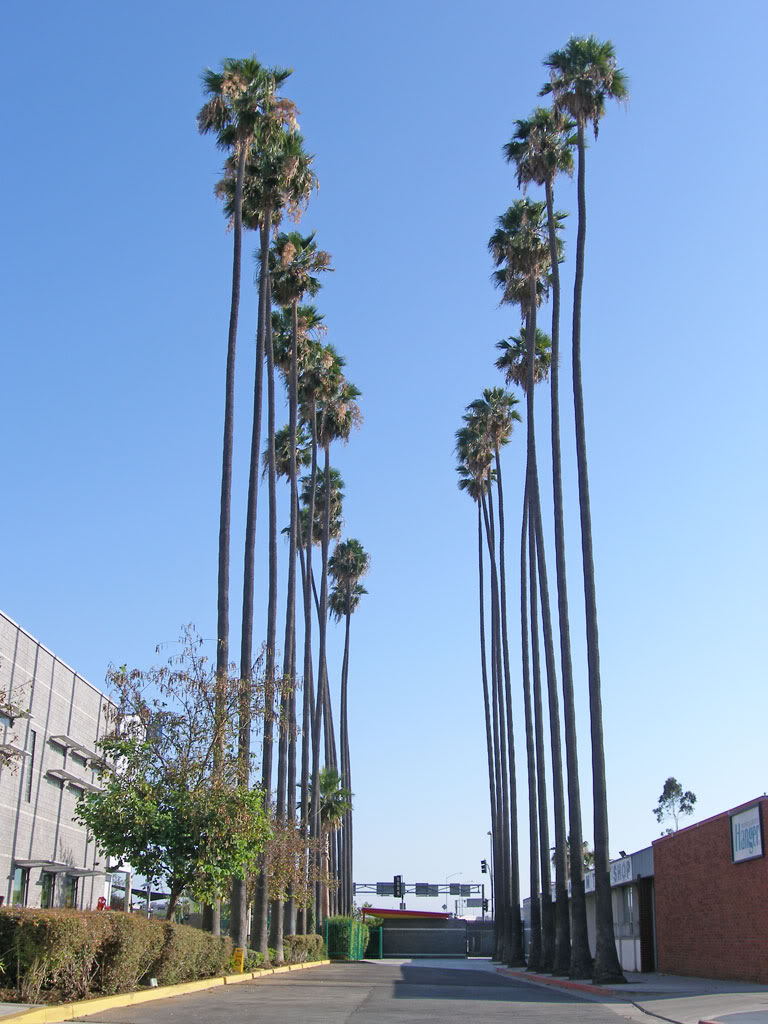Nathan Marsak recently sent me this lush postcard image of the palm drive of Singleton Court in West Adams, circa 1915. These are the
Longstreet palms which I've written about
previously. Planted circa 1875, the 23 Longstreet palms that remain today are quite possibly the oldest living things in Los Angeles. These trees have a
continuous documented photographic history which alone affirmatively attests to their great age.
Palm Drive, Singleton Court, West Adams, c.1915:

The same view of Palm Drive, 2009:

Photo by J Scott Shannon.
These palms actually began life during the Civil War, almost a century and a half ago.
Only five buildings still standing in all of Los Angeles are older (dead link) than these palm trees. They may look just like any others, but the Longstreet palms are really quite special, indeed...




4 comments:
The "Longstreet palms" story gets more and more complicated. This is the first time I've seen anything about "Singleton Court"--it doesn't appear on any of the old maps, but here it is in a postcard view. What is "Palm Drive" on the maps was at one time called Singleton Court...? Also--any definitive news on the connection of the palms to the Civil War general? Or do we think that there is just confusion because of the famous name?
Here's a fairly concise account of the Singleton Court era of the Longstreet Tract:
http://www.oac.cdlib.org/ark:/13030/kt7199r6xr/?layout=metadata&brand=oac4
I'm convinced now that the famous Confederate General was in no way connected to the palm drive of West Adams. It was a General 'Joseph' Longstreet who planted the palms. I'm still trying to find out more about him, but my search has pretty much reached a dead-end.
This doesn't in any way lessen the importance of the old palms, though. No matter who planted them, their antiquity alone is remarkable enough to warrant admiration.
Do you have any information about the Twin Palms, which must have stood in present-day Chinatown? They're mentioned in a guidebook from about 1900, but I haven't seen anything else about them.
Singleton Court, located on 3 1/2 acres at 2400 South Flower Street in the West Adams district of Los Angeles, was a Colonial Revival style home, and the residence of John Singleton. Singleton made his fortune as the president of the Yellow Aster Mining Co. in Randsburg, California. Sometime before 1918, the house was destroyed by fire, leaving only the brick stable building. A later owner, John Brockman, deeded the property to the Los Angeles Orthopaedic Foundation, and the stables were converted into a clinic. The clock tower was removed to Brockman's estate in Glendale. Between 1880 and 1925, West Adams was a fashionable neighborhood for the very wealthy, and many of Los Angeles' finest architects designed homes there. During the 1950s and 1960s, the construction of the Santa Monica and Harbor Freeways resulted in the destruction of many historic buildings, but in the 1990s, three areas of West Adams were designated as Historic Preservation Overlay Zones by the city of Los Angeles, preventing further destruction.
Post a Comment
Note: Only a member of this blog may post a comment.